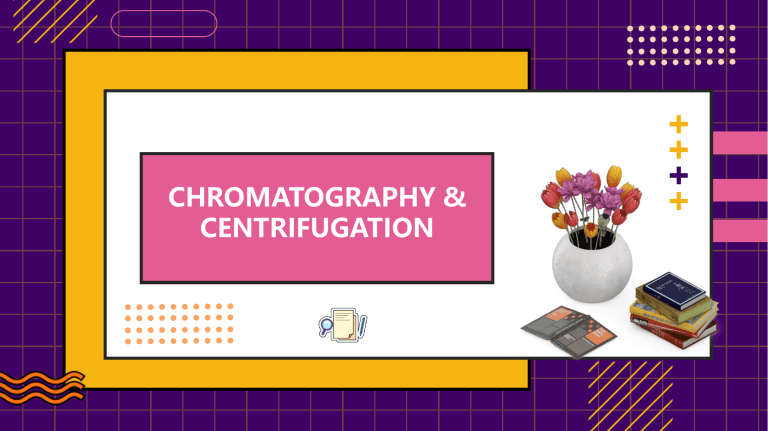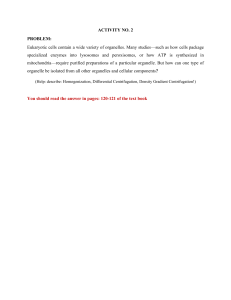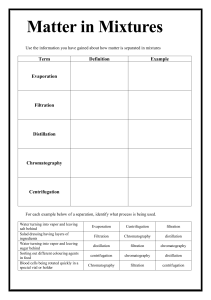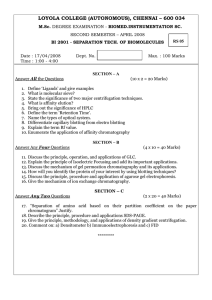
CHROMATOGRAPHY & CENTRIFUGATION INTRODUCTION Analytical chemists have few tools as powerful as chromatography to measure distinct analytes in complex samples. The power of chromatography comes from its ability to separate a mixture of compounds, or “analytes”, and determine their respective identity (chemical structure) and concentration. And Centrifugation to collect cells, to precipitate DNA, to purify virus particles, and to distinguish subtle differences in the conformation of molecules. LEARNING OBJECTIVES: At the end of lesson the student will be able to: Define chromatography; Understand the process of chromatography ; Discuss The Different Types of Chromatography; Explain centrifugation Determine the different types of centrifugation What is Chromatography? Derived from the Greek word Chroma meaning colour, chromatography provides a way to identify unknown compounds and separate mixtures How it works In all chromatography there is a mobile phase and a stationary phase. The stationary phase is the phase that doesn't move and the mobile phase is the phase that does move. The mobile phase moves through the stationary phase picking up the compounds to be tested. As the mobile phase continues to travel through the stationary phase it takes the compounds with it. At different points in the stationary phase the different components of the compound are going to be absorbed and are going to stop moving with the mobile phase. This is how the results of any chromatography are gotten, from the point at which the different components of the compound stop moving and separate from the other components. High Performance Liquid Chromatography Used in the world to test water samples to look for pollution in lakes and rivers. It is used to analyze metal ions and organic compounds in solutions. Liquid chromatography uses liquids which may incorporate hydrophilic, insoluble molecules. Gas Chromatography Used in airports to detect bombs and is used is forensics in many different ways. It is used to analyze fibers on a persons body and also analyze blood found at a crime scene. In gas chromatography helium is used to move a gaseous mixture through a column of absorbent material. Thin-layer Chromatography Uses an absorbent material on flat glass or plastic plates. This is a simple and rapid method to check the purity of an organic compound. It is used to detect pesticide or insecticide residues in food. Thin-layer chromatography is also used in forensics to analyze the dye composition of fibers. Paper Chromatography One of the most common types of chromatography. It uses a strip of paper as the stationary phase. Capillary action is used to pull the solvents up through the paper and separate the solutes. C E N T R I F U G AT I O N Centrifugation 01 is a technique of separating substances which involves the application of centrifugal force. The particles are separated from a solution according to their size, shape, density, the viscosity of the medium and rotor speed. TYPES OF CENTRIFUGUTION Density gradient centrifugation I. Rate zonal centrifugation II. Isopynic or sedimentation equilibrium centrifugation Differential centrifugation Ultra centrifugation DENSITY GRADIENT CENTRIFUGATION It allow separation of many or all components in a mixture and allows for measurement to be made There are two forms of Density gradient centrifugation : Rate zonal centrifugation Isopynic or sedimentation equilibrium centrifugation DENSITY GRADIENT CENTRIFUGATION RATE ZONAL CENTRIFUGATION In Rate zonal centrifugation the solution have a density gradient. The sample has a density i.e. greater than all the layers in the solution. The sample is applied in a thin zone at the top of the centrifuge tube on a density gradient. Under centrifugal force, the particles will begin sedimenting through the gradient. RATE ZONAL CENTRIFUGATION The particles will begin sedimenting in separate zones according to their size shape and density. ISOPYNIC OR SEDIMENTATION EQUILIBRIUM CENTRIFUGATION • In this type of centrifugation , the solution contains a greater range of densities. • The density gradient contains the whole range of densities of the particles in the sample. • Each particle will sediment only to the position in the centrifuge tube at which the gradient density is equal to its own density. ISOPYNIC OR SEDIMENTATION EQUILIBRIUM CENTRIFUGATION In Isopycnic centrifugation separation of particles occurs into zones on the basis of their density differences, independent of time. DIFFERENTIAL CENTRIFUGATION • Differential centrifugation (also known as differential velocity centrifugation) is a very common procedure in biochemistry and cell biology, which is used to separate organelles and other sub- cellular particles based on their sedimentation rate. ULTRACENTRIFUGATION • Svedberg coined the term “ultracentrifuge". He was colloid chemist. • He used the ultracentrifuge to determine the MW and subunit structure of hemoglobin , studies which changed the ideas concerning the structure of proteins. • The first commercial ultracentrifuge was produced in 1940 by SPINCO.



